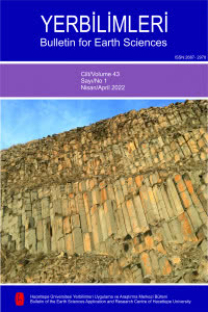Küre piritli bakır cevherinin liçinde sülfür ve demir oksidayonu yapan bakterilerin metal kazanımına etkisi
Effect of sulphur and iron-oxidizing bacteria on metal recovery in leaching of Kure piritic copper ore
___
Ahonen, L., and Tuovinen, O.H., 1989. Effect of temperature on the microbiological leaching of sulfide ore material in percolators containing chalcopyrite, pentlandite, sphalarite, pyrrhotite as main minerals. Biotechnology Letters, 11, 31-336.Akçıl, A., 2002. A preliminary research of acid pressure leaching of pyritic copper ore in Küre Copper Mine, Turkey. Minerals Engineering, 15(12), 1193-1197.
Akçıl, A., 2003. Sülfitli cevherlerden Acidithiobacillus ferrooxidans ile bakır kazanımı, Süleyman Demirel Üniversitesi, Araştırma Projeleri Yönetim Birimi, Proje No: 560.
Akçıl, A., and Çiftçi, H., 2003a. Metals recovery from multimetal sulphide concentrates (CuFeS2-PbS-ZnS): Combination of thermal process and pressure leaching. International Journal of Mineral Processing, 72(1-4), 327-334.
Akçıl, A., and Çiftçi, H., 2003b. Küre bakır cevherinin bakteriyel liçi. Madencilik Dergisi (basımda).
Akçıl, A., and Çiftçi, H., 2003c. Mezofilik bakteriler kullanılarak bakır cevherlerinin biyoliçi: Acidit-hiobacillus ferrooxidans ve Leptospirillum fer-rooxidans'm oksidasyon kapasitesi. Geoso-und/Yerbilimleri Dergisi (basımda).
Bailey, A.D., and Hansford, G.S., 1993. Factors affecting the biooxidation of sulphide minerals at high concentrations of solids: a review. Biotechnology and Bioengineering, 12(10), 1164-1174.
Bevilaqua, D., Leite, A.L.L.C., Garcia, O., and Tuovi-nen, O.H., 2002. Oxidation of chalcopyrite by Acidithiobacillus ferrooxidans and Acidithioba-cillus thiooxidans in shake flasks. Process Biochemistry, 38, 587-592.
Bosecker, K., 1987. Microbial leaching. In: Fundamentals of Biotechnology, P. Prave, U. Faust, W. Sittig, D.A. Sukatsch, (eds.), Chapter 17, 661-683.
Bosecker, K., 1997. Bioleaching: metal solubilization by microorganisms. FEMS Microbiology Reviews, 20, 591-604.
Brierley, C.L., 1995. Bacterial oxidation. Engineering Mining Journal, 196, 42-44.
Brierley, C.L., 2001. Bacterial succession in bioheap leaching. Hydrometallurgy, 59, 249-255.
Brierley, J.A., and Brierley C.L., 2001. Present and future commercial applications of biohydrome-tallurgy. Hydrometallurgy, 59(2-3), 233-239.
Çiftçi, H., 2003. Asidofilik bakteriler yardımıyla kalkopirit biyoliçinde katı oranının etkisi. Süleyman Demirel Üniversitesi Fen Bilimleri Enstitüsü, Yüksek lisans tezi, 121 s.
Deveci, H., 2002. Effect of solids on viability of acidophilic bacteria. Minerals Engineering, 15, 1181-1189.
Deveci, H., Akcıl, A., and Alp, I., 2003. Parameters for control and optimization of bioleaching of sulphide minerals. In: International Symposium Process Control and Optimization in Ferrous and Non Ferrous, F. Kongoli, B. Thomas, K. Sawamiphakdi, (eds.), November, Chicago, USA, 9-12.
Dutrizac, J.E., 1981. The dissolution of chalcopyrite in ferric sulfate and ferric chloride media. Metallurgy Transactions 12B, 371-378.
Dutrizac, J.E., 1989. Elementel sulphur formation during the ferric sulphate leaching of chalcopyri-te. Canadian Metallurgical Quarterly, 28(4), 337-344.
Dutrizac, J.E., and MacDonald, R.J.C., 1974. Ferric iron as a leaching medium. Mineral Science Engineering, 6(2), 59-100.
Ehrlich, H.L., 1996. Geomicrobiology. Dekker, New York.
Garcia Frutos, F.J., 1998. Bacterial leaching of minerals. In: Mineral Processing and the Environment, G.P. Gallios and K.A. Matis, (eds.), Klu-wer Academic Publishers, 43-72.
Hiroyoshi, N., Hirota, M., Hirajima, T., and Tsuneka-wa, M., 1999. Inhibitory effect of iron-oxidising bacteria on ferrous-promoted chalcopyrite leaching. Biotechnology and Bioengineering, 64, 478-483.
Hiskey, J.B., and Wadsworth, M.E., 1975. Galvanic conversion of chalcopyrite. Metallurgy Transaction, 6B, 183-190.
Kawatra S.K., and Natarajan K. A., 2001. Mineral Biotechnology. Society for Mining, Metallurgy and Exploration, 263 pp.
Markosyan, G.E., 1972. Ein neues eisenoxidierendes bacterium - Leptospirillum ferrooxidans nov. gen. nov. spec. Translated from: Akad. Nauk Armj. SSR Biol. Z. Armen. Bol. XXV, 26-29.
Nemati, M., and Harrison, S.T.L., 2000. Effect of solid loading on thermophilic bioleaching of sulfi-de minerals. Journal of Chemical Technology and Biotechnology, 75, 526-532.
Pooley, F.D., 1987. Mineral leaching with bacteria. In: Environmantal Biotechnology, F.F. Christopher and D.A. John, (eds.), Ellis Horwood Ltd. Publishers, John Wiley and Sons, 114-134.
Pooley, F.D., 1998. The role of biohydrometallurgy in mineral processing. In: Proceedings of the 7th International Mineral Processing Symposium, Innovations in Mineral and Coal Processing, İstanbul, Turkey, 435-446.
Rossi, G., 1990. Biohydrometallurgy. New York, McGraw-Hill.
Seifelnassr, A.A.S. ve Abouzeid, A.Z.M., 2000. Cevher hazırlamada yeni eğilimler: bakteriyel akti-vitelerin kullanımı. Ore Dressing/Cevher Hazırlama, 4, 17-41.
Suzuki, I., 2001. Microbial leaching of metals from sulfide minerals. Biotechnology Advances, 19, 119-132.
Third, K.A., Cord-Ruwisch, R., and Watling, H.R., 2000. The role of iron-oxidizing bacteria in stimulation or inhibition of chalcopyrite bioleaching. Hydrometallurgy, 57, 225-233.
Tipre, D.R., Vora, S.B., and Dave, S.R., 1999. Comparative copper and zinc bioextraction at various stages of scale up using T. ferrooxidans consortium In: Biohydrometallurgy and the Environment Toward the Mining of the 21st Century, R. Amils and A. Ballester (eds.), Part A (Bioleaching, Microbiology), 159-166.
Torma, A.E., 1977. The role of Thiobacillus ferrooxi-dans in hydrometallurgical processes. Advances in Biochemical Engineering, 6, 1-37.
Tshilombo, A.F., Petersen, J., and Dixon, D.G., 2002. The influence of applied potentials and temperature on the electrochemical response of chalcopyrite during bacterial leaching. Minerals Engineering, 15, 809-813.
Waksman, S.A., and Joffe, I.S., 1922. Micro-organisms concerned with the oxidation of sulphur insoil. II. Thiobacillus thiooxidans, a new sulphur oxidising organism isolated from the soil. Journal of Bacteriolology, 7, 239-256.
- ISSN: 1301-2894
- Yayın Aralığı: 3
- Başlangıç: 1976
- Yayıncı: Hacettepe Üniversitesi Yerbilimleri Uygulama ve Araştırma Merkezi
Ayşegül YILDIZ, Vedia TOKER, Huriye DEMİRCAN, Serkan SEVİM
Engin MERİÇ, İ. Erdal KEREY, Niyazi AVŞAR, A. Beril TUĞRUL, Fikret SUNER, Aslı SAYAR
1 Mayıs 2003 Bingöl depremi (Mw=6.4) kuvvetli hareket kayıtlarının incelenmesi
Macun dolgu dayanımını ve duraylılığını etkileyen faktörler
Erol Yılmaz, Ayhan Kesimal, Bayram Erçıkdı
1 Mayıs 2003 Bingöl depremi ($M_W$=6.4) kuvvetli hareket kayıtlarının incelenmesi
